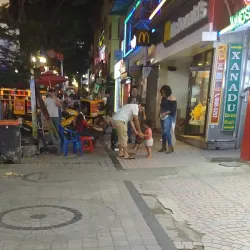Crime and Pollution in Pyeongtaek
The following data and statistics on crime, pollution, and overall safety in Pyeongtaek are derived from a combination of trusted public sources and insights gathered from over 2 user contributions.
This comprehensive approach helps provide a balanced view of the city's crime rates, environmental concerns, air quality, and public safety. By aggregating information from government reports, environmental studies, and direct feedback from residents, we aim offer an up-to-date and thorough analysis of key factors impacting quality of life in Pyeongtaek.
Crime Data in Pyeongtaek
Crime Perception and Concerns
In 2024, Pyeongtaek stands out with remarkably low crime levels. The city's residents experience an exceptionally high sense of safety both during the day and night, with minimal concerns about criminal activities.
Public safety in Pyeongtaek is highly regarded, with comprehensive measures effectively keeping crime fears dramatically low among its populace.
Some notable concerns include:
- Property Crimes - Property crimes such as theft and break-ins are virtually non-existent concerns for Pyeongtaek residents, indicating strongly favorable perceptions of local security.
- Drug-Related Issues - Drug-related crimes are not a point of significant worry in Pyeongtaek, reflecting a well-managed environment free from such disturbances.
- Violent Crimes - The concern for violent crimes such as assaults is negligible, largely due to effective law enforcement and a cohesive community atmosphere that deters potential threats.
- Public Safety - Pyeongtaek is perceived as exceedingly safe, with residents expressing confidence in their safety at all hours. Such sentiment is a testament to the city's effective safety protocols and community vigilance.
Crime Trends and Safety
- Rising Crime Concerns - There is practically no concern about rising crime rates in the city, with the perception that crime is on a downward trend, enhancing the public's feeling of security.
- Specific Fears - Specific fears about crime, whether related to physical assault, theft, or other offenses, are largely absent. This reflects a well-protected community where residents feel secure and at ease.
Summary of Crime in Pyeongtaek
Pyeongtaek in 2024 benefits from near-negligible crime levels, reinforcing its reputation as one of the safest places. Continual efforts to maintain this status, coupled with strong community engagement, are vital to sustaining this level of safety.
Crime Rankings
The crime ranking by city for South Korea is based on a continuously updated index, incorporating data up to 36 months old and calculated twice a year. Cities are ranked on a scale from "very low" to "very high" crime levels, with safety being the inverse, where a high safety index indicates a safer city.
Pollution Data in Pyeongtaek
Air Quality and Pollution Levels
Despite Pyeongtaek's commendable safety, it faces significant challenges concerning pollution, particularly regarding air quality. Industrial activities and urban factors contribute to these environmental concerns.
Air quality is notably poor, with residents expressing dissatisfaction and concerns about the impact on health and quality of life.
- PM2.5 (Fine Particulate Matter) - The PM2.5 level is not an immediate concern, registering at negligible levels; however, this does not fully mitigate broader air quality issues in the city.
- PM10 (Coarse Particulate Matter) - PM10 levels also appear low; however, the overall perception suggests that other air quality factors contribute to dissatisfaction.
Waste and Noise Pollution
Challenges with waste management are pronounced, with many residents expressing discontent over garbage disposal and cleanliness.
Noise and light pollution levels are moderate, yet they contribute to the overall environmental concerns of Pyeongtaek.
- Garbage Disposal Satisfaction - Garbage disposal dissatisfaction is high, signaling significant room for improvement in waste management services and policy implementation.
- Noise and Light Pollution - While noise pollution is moderate, it remains a concern for residents, particularly in bustling urban areas, affecting overall lifestyle satisfaction.
Green Spaces and Water Quality
Residents find the quality of green spaces lacking, contributing to low satisfaction, and highlighting the need for enhanced urban planning.
Water quality perception is generally negative, with residents wishing for clearer and more dependable water systems.
- Green and Parks Quality - Green areas do not meet resident expectations, leading to calls for improved urban green space development and maintenance.
- Drinking Water Quality - The quality and accessibility of drinking water are concerns for residents, who desire improvements in both taste and reliability.
Pollution Rankings
The pollution ranking for South Korea is based on a combination of visitor perceptions and data from institutions like the World Health Organization. The Pollution Index estimates overall pollution levels by considering air and water pollution, garbage disposal, and other factors, with air pollution given the highest weight, while the Pollution Exp Scale uses an exponential function to highlight extremely polluted cities.
"Key Takeaways"
Pyeongtaek boasts exceptionally low crime rates, providing a strong sense of security and safety, unfortunately offset by substantial pollution-related challenges.
Environmental concerns, particularly relating to air quality and waste management, highlight areas for potential growth to match the city's exceptional safety standards.
Future policies in Pyeongtaek should address these pollution issues while maintaining its status as a low-crime and highly safe city.










